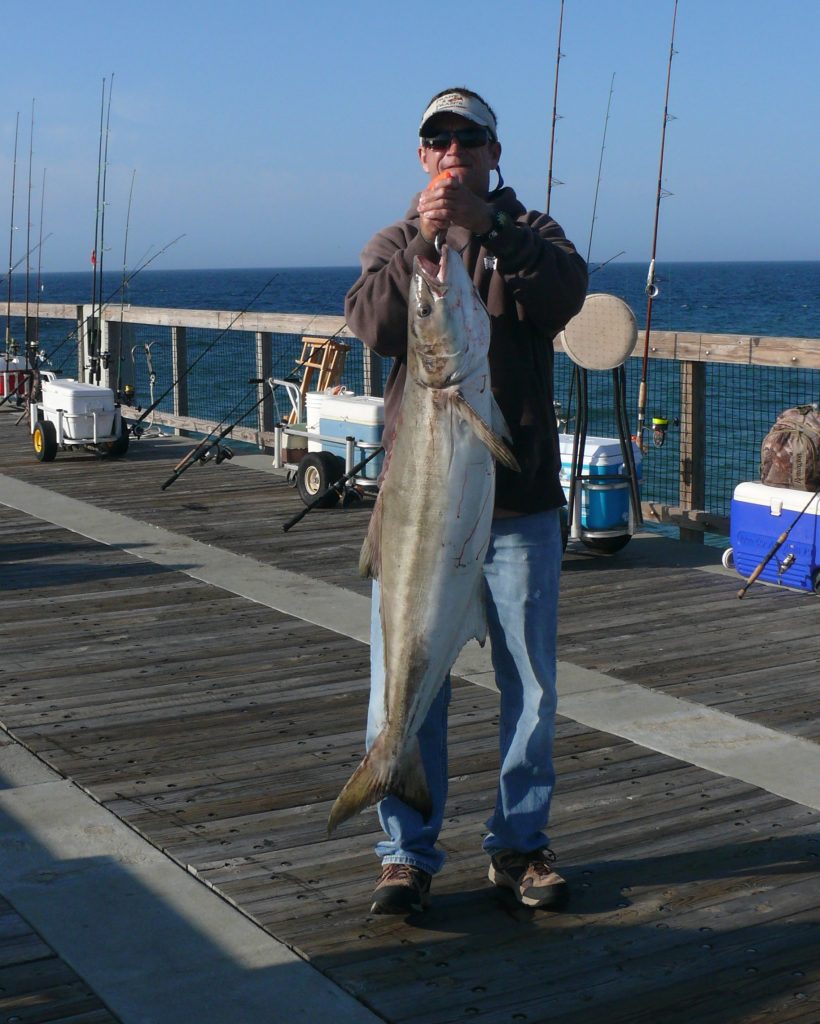Even if you don’t have a power-boat, Cobia can be targeted near shore.
There is something about the spring run of cobia (also called ling or lemonfish) that turns coastal anglers into competitive sportsmen who make Mohammed Ali seem gentle in comparison. When the season begins in the spring, a large group of fishermen who only pier fish for cobia emerge like bears from their dens. They vie for the ‘best spot’ on the pier, staking their claim as early as possible. In fact, being the first to catch a cobia from the pier in spring is somewhat of a status symbol, so there is a lot riding on getting the right spot, having the best set up and making sure you leave nothing to chance.

A Passion for Pier Fishing
According to Sam Patrick, also known as the “King of Pier Fishing” by some of his peers, the cobia season hits its prime in April. Sam writes the weekly fishing report for Bay County Outdoors and is on the pier for five to six days per week. If anyone knows Gulf Coast cobia pier fishing, Sam does. As he explains, those fishing for cobia from piers will stand for hours on end at the rail watching for the migrators. They are sight fishing for these fish that can look very similar to catfish or sharks to come riding in on the tops of waves. Upon spotting a fish, pier etiquette dictates the “first cast rule.” Whoever first spots the fish calls “first cast” loudly. Once that person casts, everyone else around them casts as well. The ensuing melee can become quite dangerous as multitudes of extremely focused fishermen begin throwing around weighted jigs with sharp hooks. Between the tension on the pier and the potentially injury-inducing equipment, one would almost feel safer to be wearing a helmet.
They fish with custom jigs in a rainbow of their favorite colors — pink, green, white, purple, red and black. The color selection varies depending on the fisherman’s preference and the time of the season. When an unsuspecting fish sees the jig that it can’t resist on its way past the pier, the fight is on! Cobia put up a hard fight, which is one of the reasons they are such a popular target in sportfishing. When catching them from a pier, the objective is to land them as quickly as possible before they have a chance to wrap the line around a piling and cut it on a barnacle. While that might sound easy to do, bear in mind that the average cobia caught from the pier in Panama City, Florida is thirty-five pounds, with the big fish last year weighing in at a whopping fifty pounds! Imagine not only fighting that fish but gaffing or netting it to get it up to the pier. As the season goes on, the fish caught are smaller and most fishermen change their gear from brightly colored jigs to live bait or eels. As with all game, equipment must adapt to the season.
Kayaking for Cobia
While there are those who are passionate about pier fishing for cobia, there are others who are equally ardent about catching these fish from a kayak. Jerry McBride, the author of Hobie’s fishing blog and an avid kayak fisherman, is a wealth of knowledge when it comes to kayak fishing. “Fishing for cobia from a kayak can be challenging because boats with towers can spot them and get to them faster,” states Jerry. If you want to catch cobia from a kayak, you need to be in an area where you are not competing with boats. In his experience, west of Panama City Beach is a favorable location. Underneath bridges can be promising as well as around channel markers and buoys. Shallow water is not a problem, as this year Jerry was reeling in a trout in three feet of water and had two 35-50 pound cobia swim right under his kayak! He has also had a school of cobia follow him as he was paddling.
“If fishing with live bait, crab is an excellent choice.”
Cobia are strong, aggressive fish and can be caught readily with live bait or with lures. One of their nicknames is “crab-eater” as their diet is largely comprised of crab. If fishing with live bait, crab is an excellent choice. When selecting a lure, colorful jigs, plastic eels and small plastic crabs and shrimp are all very effective. For ease of use, spinning tackle is generally recommended, but conventional tackle also works well once you become familiar with it.
Cobia Conservation
Though there may be some disagreement about the best way to catch these fish, there is one subject that everyone I spoke with agreed on … the need for conservation. Cobia numbers have appeared to dwindle since a federal assessment of the fish in 2013. As a result of concerned groups of anglers and conservationists who have been petitioning for changes to the current regulations, as of February 1, 2018, the recreational and commercial bag limits in Gulf state waters will become the same by reducing the commercial trip limit from two to one fish per person. Additionally, the recreational and commercial vessel limit in Gulf state waters has been reduced from six to two per vessel per day. The 33-inch fork length minimum size limit will not change at that time.
Whether you want to brave the tackle-wielding hordes for a chance at catching the first cobia of the season and being the ‘top dog’ on the pier or you prefer the serenity and close-to-the-water experience of fighting these big fish from a kayak, the gulf coast offers some great opportunities to try either … or both.




